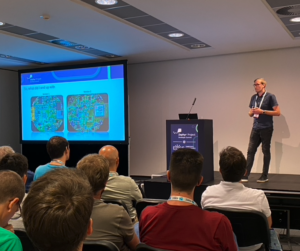The Zephyr Developer Summit, hosted under the first-ever Embedded Open Source Summit in Prague, Czech Republic, on June 27-30 included presentations, BoFs, and training designed for real time problem solving and deep discussions. More than 1,300 people registered for the EOSS conference – representing 375 organizations across 56 countries around the globe. Zephyr had 75+ technical sessions (in-person and on-demand) for 3 tracks focused on users of Zephyr, developers contributing upstream, and maintainer-specific topics.
All of the videos from the Zephyr Developer Summit can be found on the Zephyr Youtube Channel. Each week, we’ll highlight a few videos and links to their presentations in a blog for easy access. Today, we’re featuring some of the sessions that feature products and how they run on Zephyr RTOS including: brewce: Brewing Beer with Zephyr, Android and Thingsboard, Building an Open Source Smartwatch Using Zephyr and Build a Pump Monitor for Railway Applications with Zephyr OS.
brewce: Brewing Beer with Zephyr, Android and Thingsboard – Christian Hirsch, Entrepreneur, Researcher and Hobby beer brewer
Beer is one of the oldest known cultural beverages. Its main ingredients are water, (barley) malt, hop and yeast. The process of brewing beer is well-known and in order to dissolve the starch from the malt into the water, also called mashing, the malt and water mixture is heated up to specific temperatures that need to be hold for a certain amount of time. This gives the enzymes in the malt the ability to break up the starch to dissolve it. Hobby brewers normally use home brew kits and commercially available equipment to brew their own beer. In this video, Christian Hirsch presents brewce: a setup of home-brewed electronics for home brewing beer. brewce consists of four devices: a modified induction cooker, a temperature sensor, a pump control and a smartphone. The induction cooker was reverse engineered and equipped with some electronics which runs the Zephyr RTOS and which lets one control it via Bluetooth Low Energy (BLE). The same is true for the temperature sensor and the pump control. An Android app on a smartphone connects to all three devices via BLE and controls the induction cooker and a pump based on the temperature sensor’s readings to run the mashing procedure. Christian presents the setup, the electronics and firmware, the obstacles and the results. The PPT presentation can be found here.
Building an Open Source Smartwatch Using Zephyr – Jakob Krantz, Senior Embedded Software Engineer, u-blox

Build a Pump Monitor for Railway Applications with Zephyr OS – Oliver Völckers, Founder and CEO of BeST Berliner Sensortechnik & Jonas Remmert, Embedded Systems Engineer at Phytec Messtechnik GmbH

The system uses the nRF9160 SiP to track pump usage data and send it to the cloud via LTE-M/NB-IoT. The pump monitor features temperature, moisture, and pressure sensors, as well as an accelerometer. It performs pattern recognition to evaluate the pumping process and send an encoded assessment to a cloud server via MQTT. The system is being used by German railway operator Deutsche Bahn for monitoring wastewater tanks on high-speed trains. It currently runs maintenance-free for up to three months before battery recharge is needed.
This video, based on a presentation given at the IoT-Congress Munich in October 2022, will dive deeper into the electronic and software architecture design. Furthermore it will be shown how Zephyr helped solving many challenges and offered significant advantages over other ecosystems such as vendor-exclusive SDKs. Key design decisions in hardware and firmware during the development of the system will be explained. Many of those design decisions are generally applicable in low power projects. View the PPT presentation here.
Watch the rest of the Zephyr Developer Summit videos here.
For more information about the 2024 event, stay tuned by subscribing to the Zephyr quarterly newsletter or connect with us on @ZephyrIoT, Zephyr Project LinkedIn or the Zephyr Discord Channel to talk with community and TSC members.
